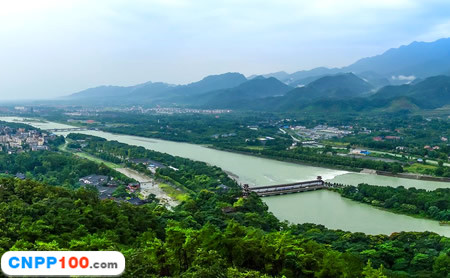
Sichuan Qingcheng Mountain, Dujiangyan, a world natural and cultural heritage, a national 5A-level scenic spot, a hot tourist attraction in Sichuan, has a long history of Taoist "museum", known as "the blessed land of the heavens" and "the fairyland of the world".
Qingcheng Mountain and Dujiangyan are located in Dujiangyan City, Sichuan Province, national AAAAA level tourist attractions, Qingcheng Mountain and Dujiangyan are about 15 kilometers apart, the main peak is 1260 meters above sea level, more than 200 miles in radius, the mountains and rivers are beautiful in all seasons, the clouds and mist are swirling, the shape is like a city, so it is called Qingcheng Mountain. It is famous for its deep and quaint elegance, and is known as "Qingcheng is secluded in the world". Dujiangyan is a world-famous ancient comprehensive large-scale water conservancy project, at the foot of Yulei Mountain, Guankou Town, Dujiangyan City, more than 2,200 years ago, it was built by Li Bing, the county guard of Shu County of Qin State, and the project mainly includes three parts of fish mouth, flying sand weir and treasure bottle mouth, making Chengdu Plain become "the land of abundance".
Dujiangyan City is rich in tourism resources and has a world-renowned world cultural heritage - Dujiangyan • Qingcheng Mountain, which is an important part of the world natural heritage of Sichuan giant panda habitat, and has won the "First Chinese Habitat Environment Model Award", "United Nations Dubai International Good Practice Award for Improving Living Environment", "China Excellent Tourism City", "National Key Scenic Area", "National Historical and Cultural City", "National Ecological Demonstration Zone", "National Garden City" and other awards.
Mount Qingcheng
Mount Qingcheng is a World Cultural Heritage Site; In 2000, it was inscribed on the World Heritage List.
Qingcheng Mountain is backed by the Minjiang River, overlooking the Chengdu Plain in western Sichuan, with a group of peaks and peaks, like a city; It is located in Dujiangyan Scenic Area in Chengdu, Sichuan. The scenic area is 200 square kilometers; There are 36 peaks, 8 large holes, 72 small holes, and 108 scenic spots. It is the birthplace of China's famous Taoism, and is listed as the "Fifth Cave Heaven" by Taoism; The ancient trees in the mountain are towering to the sky, surrounded by peaks, the four seasons are like spring, the mountains and forests are deep, the pavilions are elegant, and the streams are quiet and clear, so it has the reputation of "Qingcheng is secluded in the world"; It is 16 kilometers away from Dujiangyan downtown.
The scenery in front of Qingcheng Mountain is beautiful, there are many cultural relics and historic sites, there are dozens of Taoist palaces that have been well preserved so far, there are a large number of estimated cultural relics and the handwriting of modern masters, it is a Taoist "museum" that spans thousands of years.
Attraction introduction
Famous scenic spots are: Shangqing Palace, Jianfu Palace, Tianshi Cave, natural pictures, etc. The natural scenery of the back mountain is primitive and gorgeous, such as the peach orchard, beautiful and mysterious.
Shangqing Palace
Shangqing Palace, was built in the Jin Dynasty, the existing temple was built during the Tongzhi period of the Qing Dynasty, there are "the fifth mountain in the world", "the first peak of Qingcheng" and other Moshan stone carvings. Qingcheng Mountain belongs to the subtropical warm and humid monsoon climate zone, with an average annual temperature of about 15 °C, known as "the blessed land of the cave" and "the fairyland of the world".
Jianfu Palace
Jianfu Palace, located at the foot of Zhangren Peak; It was built in the Tang Dynasty, and has been repaired many times after generations, and now only two halls and three courtyards remain. Jianfu Palace is built under the cliff, the bearing is extraordinary, its left side is the ruins of the princess of Mingqing Mansion, from which one thousand meters to the west, that is, to the natural picture. Here the rocks are towering, the clouds are shrouded, and visitors come here as if in the picture. Two kilometers to the north, you will arrive at the Tianshi Cave of the main temple of Qingcheng. Legend has it that Zhang Daoling in the late Eastern Han Dynasty had preached here, the three emperors of the main hall of the Tang Dynasty were carved in stone for the three emperors, the existing stone and wood tablets of the past dynasties in the hall were carved in the hall, the most famous ones are: Tang Xuan's purpose book tablet, Yue Fei's handwritten Zhuge Liang before and after the teacher table, etc. Out of the Heavenly Master Cave, visit Ningqiao, then go to the Patriarch's Palace, and then go north, you can go to Chaoyang Cave, and go out directly to the Shangqing Palace on the high platform.
Dujiangyan
The famous ancient water conservancy project Dujiangyan, located in the west of Dujiangyan City, Sichuan, belonged to Du'an County in ancient times and was named Du'anyan, called Dujiangyan after the Song and Yuan Dynasties, and was known as the "treasure of Zhenchuan" of "unique and eternal". Dujiangyan was built in the third century B.C., is a large-scale water conservancy project built by Li Bing, the Taishou of Shu County of Qin State and his son during the Warring States Period of China, and is the oldest and only surviving grand water conservancy project in the world so far, characterized by the diversion of water without dams. For more than 2,200 years, it still plays a huge role, Li Bing's water control, the merit in the present generation, the benefit in the future, worthy of the great masterpiece of the civilized world, the great water conservancy project for the benefit of the people. It is the world's oldest and only surviving grand water conservancy project characterized by water diversion without dams. It is a monument in the history of science and technology in China. The most important part of the Dujiangyan water conservancy project is the Dujiangyan canal head project, which is the key facility in the Dujiangyan irrigation system. The head of the canal is mainly composed of three major projects: the Yuzui diversion embankment, the Baohuakou water diversion project and the Feishayan spillway. Before the pile was excavated at the mouth of the treasure bottle, it was a part of the Hutou Rock of Maoshan Mountain. According to the characteristics of the water flow and the terrain, Li Bing chiseled a wedge-shaped opening with a bottom width of 17 meters at the gentle slope. The mouth of the gorge is 19 meters wide during the dry season and 23 meters wide during the flood season. According to the "Yongkang Military Chronicles", "on the occasion of spring ploughing, it is needed like gold, and it is called 'Golden Irrigation Mouth'". Therefore, the treasure bottle mouth was also known as the gold filling mouth in ancient times. The mouth of the treasure bottle is the throat of the water inlet of the Neijiang River, and it is the key water conservancy facility of the Neijiang River that can "water and drought from people". Due to the magnificent natural landscape of Baohuakou, it is known as "Lidui Lock Gorge", which is one of the famous "Ten Views of Guanyang" in history. The flying sand weir is the floodway in the middle section, which has the function of discharging flood water and sand and gravel, and the mouth of the treasure bottle has the function of water diversion and water inflow. Therefore, the Dujiangyan water conservancy project has scientifically solved the problems of automatic diversion, automatic sediment discharge, automatic drainage and water diversion of river water, and has received the effect of "water irrigation, flood prevention and disaster resistance, which is a great wonder in the history of water conservancy engineering in the world." For more than 250 years, water diversion and irrigation have made Shu have the reputation of "the land of abundance". Dujiangyan is the source of wealth of "Tianfu", and still plays an irreplaceable role, irrigating more than 10 million acres of fertile land.



